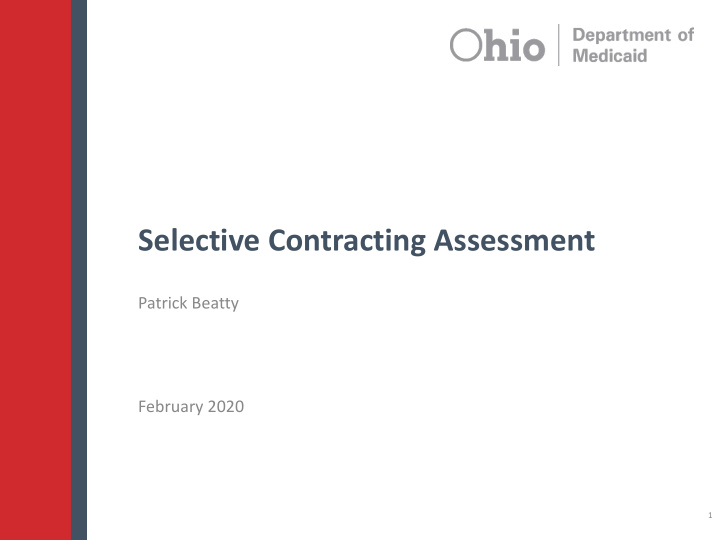



Selective Contracting Assessment Patrick Beatty February 2020 1
Current Panels Plan DME DME Selective Contracting or Sole Sourcing Suppliers Aetna 26 None Buckeye 446 Medicaid: J&B Medical for various items: https://www.buckeyehealthplan.com/content/dam/centene/Buckeye/med icaid/pdfs/JB-Medicaid-List.pdf. MyCare: J&B Medical for Incontinence supplies only: https://www.buckeyehealthplan.com/content/dam/centene/Buckeye/mm p/pdfs/JB-MyCare-List.pdf CareSource 339 DME network narrowing Molina 534 None Paramount 240 None United 650 Medicaid and MyCare: Edgepark Medical for incontinence supplies: https://www.uhcprovider.com/content/dam/provider/docs/public/commpl an/oh/prior-auth/OH-ComPlan-PA-Eff04012019.pdf; https://www.uhcprovider.com/content/dam/provider/docs/public/commpl an/oh/prior-auth/OH-MyCareOhio-PA-Effective04012019.pdf 2
Selective Contracting • http://codes.ohio.gov/oac/5160-26-05v1 allows MCOs to selective contract with preferred providers. • Plans are reporting that with the ability to create a preferred network they are able to better coordinate the services, control of the product and reduce mismanagement of the benefit. • How can we develop a document to use when to evaluate the MCO’s request for selective contracting? 3
Reimbursement Payment for the selective contracting program is: • the same as stipulated in the State Plan • Different than stipulated in the state plan and if so, describe below » Capitation, Sub capitation, Risk Based, FFS, other Are there incentive payments in the contracting design (If yes, please describe) How will rent-to-purchase products be transitioned? 4
Procurement • ODM or the MCO will select the contractor in the following manner: • Competitive procurement • Open cooperative procurement • Sole source procurement • Other (please describe) Duration The term of the contract will be _________years. 5
Geography • Statewide • Regional Provider Limitations • Beneficiaries will be limited to a single provider in their services area. • Beneficiaries will be given a choice of providers in their services area. Included Populations Section 1931 Children and related populations Section 1931 Adults and related populations 6
Include Populations cont. • Blind/Disabled adults and related populations • Blind/Disabled children and related populations • Aged and related populations • Foster care children • Title XXI CHIP children Excluded Populations • Dual Eligibles • Poverty level pregnant women • Individuals with other insurance 7
Include Populations cont. • Individuals residing in a nursing facility or ICF/MR • Individuals participating in a HCBS Waiver program • American Indians/Alaskan Natives • Special Needs Children (State Defined) • Individuals receiving retroactive eligibility • Other (please define) 8
Questions regarding timely access to services • How does the state or MCO measure the timeliness of Medicaid beneficiaries access to the services covered under the selective contracting? • Describe the remedies the State or MCO has or will put in place in the event that Medicaid beneficiaries are unable to access the contracted services in a timely fashion. • Describe how the State or MCO will ensure that its selective contracting provides a sufficient supply of contracted providers to meet the Medicaid beneficiaries’ needs. 9
Questions regarding timely access to services • Provide a detailed capacity analysis of the number of providers or vehicles needed per location or region to assure sufficient capacity under the selective contract. • Describe how the State or MCO will evaluate and ensure on an ongoing basis that providers are appropriately distributed throughout the geographic regions covered by the selective contracting programs so that Medicaid beneficiaries have sufficient and timely access throughout the regions affected by the program. 10
Ancillary Impact • Is the selective contracting for a product or services that is commonly delivered concurrently with other ancillary or related products or services bundled in delivery though not in payment? • Is the selective contract of a size that will have an impact on competing product or service providers in the region? • What is the state’s or MCO’s remedy in the event the selected product or service provider is no longer able or willing to deliver under the selected contract? • Describe how the MCO assures that coordination and continuity of care is not negatively impacted by the selective contracting program. 11
Ancillary Impact • Describe how beneficiaries will get information about the selective contracting program. • What is the transition of care timeframe? • Does the MCO have an option for members to receive the product or service from a different vendor if there was a reason? • If opt out process is or is not available, please describe why or why not. • Would the selective contracting for this product or service have an impact on the discharge process? If so, please detail the changes a discharge planner must make and how the stakeholders, including physicians, hospitals and other referral sources have been informed in a timely manner regarding the process. 12
Ancillary Impact • Is there a process in place if the selective contractor does not carry the products and supplies the patient wants? • How will the transfer of medical documentation happen? Will the physicians need to write new scripts? 13
Monitoring • MCO to report the expenditures from year one to trend rate from current expenditures to gather the % of the projected costs. • Bi-annual review of cost-effectiveness. • Initial 4 month review of trending of products and regions specific monitoring of grievances. • Collect quality outcomes. 14
Monitoring Tools • EQRO to evaluate compliance • Accreditation • MA-PD Surveys • Beneficiary Monitoring Committee • Medicaid Consumer Hotline • Review of Grievances • Care Management Data • Submission of Quarterly Improvement Survey • Independent Assessment of Program impact, access, quality, and cost-effectiveness. 15
Recommend
More recommend